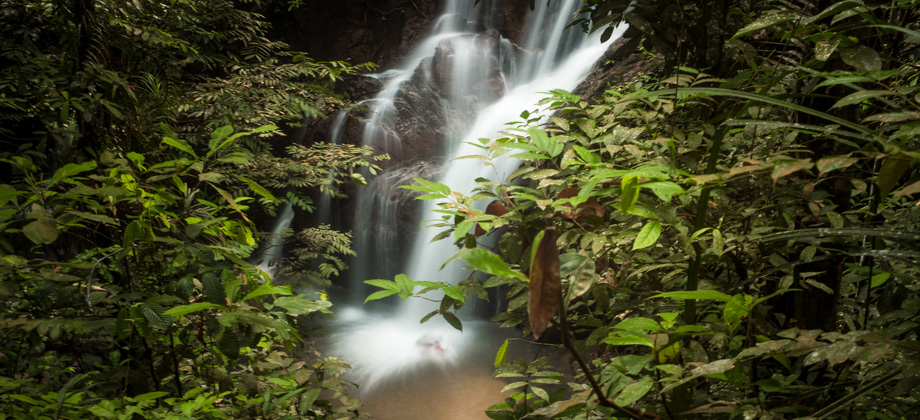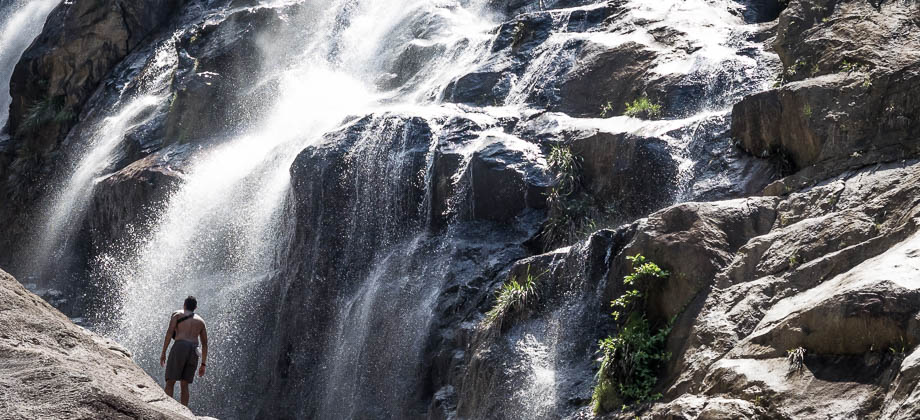Pisang Waterfall
Pisang Waterfall
PROTECTED STATUS :
The hike to Pisang waterfall is a quick and easy excursion that is not too far from the centre of Kuala Lumpur. The hike follows the Pisang river and as a result, has almost no elevation gain. This makes it perfect for beginner hikers or just for those who are looking for an easy weekend getaway. Its accessibility does unfortunately mean that the number of people that are likely to be encountered will be higher than that of more remote
waterfalls, and of course, with more people comes more rubbish.
Before we proceed any further however, I have to take a moment to make a disclaimer and to urge you to use common sense and caution when doing anything in the vicinity of the waterfall, and especially so when preceded by a bout of rain. Please also jot down the numbers that are listed below. If you do see any suspicious behaviour when out hiking, encounter things like traps and snares, or even see protected animals or their parts that are sold as either collectibles, pets, or for (so-called) medicine, then please do not hesitate to contact the wildlife crime hotline. Be sure to try and document it as best you can with photos or video without putting yourself in danger, and take note of the details: descriptions of those who are involved, as well as when and where it took place.
"The Wildlife Crime Hotline, managed by the Malaysian Conservation Alliance for Tigers (MYCAT), provides YOU an avenue to report offences involving endangered wildlife in Malaysia. We protect the identity of all informants, only key info of the reports are forwarded to the authorities."
Wildlife Crime Hotline019 356 4194
Emergency Numbers
Wildlife Crime Hotline 019-356 4194
Wildlife Department 1800 885 151
Selangor Forestry Department 03–5544 7507
Gombak Police Headquarters 03-6126 2222
Orang Asli Gombak Hospital 03-6189 2122
*Click here to learn more about the difficulty rating.

Getting There
The trail head is located just beyond the Orang Asli Gombak Hospital  along the old Gombak-Genting road. A left turn
along the old Gombak-Genting road. A left turn  approximately a kilometre up the road from the hospital leads to the Alang Sedayu lodges and camps, and along the sides of the road here is where most people park their cars.
approximately a kilometre up the road from the hospital leads to the Alang Sedayu lodges and camps, and along the sides of the road here is where most people park their cars.
Directions from Batu Caves to the side of the road where most cars are parked
The location of the trail that veers left from the road and down to the river
We walked along the road and followed it north-west to the small wooden hut of 'Zoom Bamboo Rimba', where we paid the
MYR1/pax Sungai Tua Recreational Forest entrance fee. We then walked past the boom gate and veered left before the main gate and down the trail towards the river. There was a diagonal river crossing to the path on the other side of the river just before the station, but the river was quite shallow (the water level did not even pass our knees) and was very slow-moving so the crossing did not require any additional
safety measures.
The pinnate leaves and coiled fiddleheads of
ferns were ubiquitous once we crossed the river. The green swathes along the sides of the trail were occasionally interrupted by splashes of purple here and there as touch-me-not flower heads
(Mimosa pudica), butterfly pea flowers
(Centrosema molle), and newly emerging butterfly bush flowers
(Rotheca myricoides) on tall stalks made their appearance, with each one of them on seemingly different tiers--low, medium, and high respectively. The trail veered west briefly before swerving back north along the underside of the Karak highway, and eventually to the twin culverts that passed underneath the highway itself.
 The twin culverts that pass underneath the highway
The twin culverts that pass underneath the highway
Exiting the culverts after sloshing through the water run-off and into the dense forest beyond was akin to entering a portal into another world, as the contrast between the two ends was just so stark. The other side lay the slow-moving Pisang River--its water trickling slowly over the many roots and stones--and flanking the riverbanks were the edges of the dipterocarp forest.
Ferns and rattan trees were ubiquitous here, whilst bird's nest ferns
(Asplenium nidus) could be seen perched on the trunks of the trees above, and spikemoss--both
Selaginella intermedia and
Selaginella willdenowii--and various species' of wild ginger plants, such as pendulous globba ginger
(Globba pendula), lined the trail below. Damselflies darted around from branch to branch, and the occasional leech would latch on to us as we trundled leisurely through the undergrowth.
 The trickling water of Pisang river
The trickling water of Pisang river
We barely used the trail and stuck to the river almost the entire way. Red markers that had been tied on to branches at various intervals could be seen from time to time as we followed the river north. From the culverts, it took us about 45 minutes to reach the waterfall traveling at a very slow pace. The waterfall split into several streams as it fell the 30 metres or so from the top, and into the wading pool at its base.
 The cascades of Pisang river; Pisang Waterfall
The cascades of Pisang river; Pisang Waterfall
Directly opposite the waterfall was a trail that ascended the steep slope to an extremely large camp clearing above. From there, trails ran over to the left to other clearings, and eventually to the upper tiers of the waterfall itself, before dropping back down to the other side of the river. Vibrant Raja Brooke's birdwings
(Trogonoptera brookiana), the national butterfly of
Malaysia, could sometimes be seen flitting around the mud pools around the clearings. These butterflies require sodium and potassium from the mineral-rich pools and flit around them non-stop, only staying still for a second or two at most--making macro photography almost impossible!
When Alfred Russel Wallace first named and described them, it was thought that the female variants were incredibly rare, but it turns out that they fly in the upper canopies of the trees which makes encounters with them few and far between. Alfred Russel Wallace described them as such:
"This beautiful creature has very long and pointed wings, almost resembling a sphinx moth in shape. It is deep velvety black, with a curved band of spots of a brilliant metallic-green colour extending across the wings from tip to tip, each spot being shaped exactly like a small triangular feather, and having very much the effect of a row of the wing coverts of the Mexican trogon, laid upon black velvet. The only other marks are a broad neck-collar of vivid crimson, and a few delicate white touches on the outer margins of the hind wings."
Alfred Russel Wallace
After spending some time bathing in the pool, we dried ourselves and made our way back to where we had started, eager for a good meal. The amount of time that we had spent walking there and back, excluding the time spent bathing, had been just two hours and a half, which is a perfect time for those looking for a quick half-day excursion.
Suunto Movescount Stats

 Download GPX file here (right click and save link as)
Download GPX file here (right click and save link as)

![]() along the old Gombak-Genting road. A left turn
along the old Gombak-Genting road. A left turn ![]() approximately a kilometre up the road from the hospital leads to the Alang Sedayu lodges and camps, and along the sides of the road here is where most people park their cars.
approximately a kilometre up the road from the hospital leads to the Alang Sedayu lodges and camps, and along the sides of the road here is where most people park their cars.









